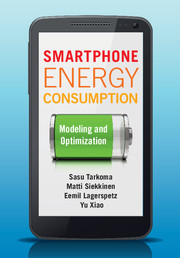Book contents
- Frontmatter
- Contents
- Preface
- List of abbreviations
- Part I Understanding energy consumption
- Part II Energy management and conservation
- Part III Advanced energy optimization
- 11 Overview
- 12 Traffic scheduling
- 13 Exploiting multiple wireless network interfaces
- 14 Mobile cloud offloading
- 15 Example scenarios for energy optimization
- 16 Future trends
- Appendix A An energy profile application
- Index
- References
14 - Mobile cloud offloading
from Part III - Advanced energy optimization
Published online by Cambridge University Press: 05 August 2014
- Frontmatter
- Contents
- Preface
- List of abbreviations
- Part I Understanding energy consumption
- Part II Energy management and conservation
- Part III Advanced energy optimization
- 11 Overview
- 12 Traffic scheduling
- 13 Exploiting multiple wireless network interfaces
- 14 Mobile cloud offloading
- 15 Example scenarios for energy optimization
- 16 Future trends
- Appendix A An energy profile application
- Index
- References
Summary
A seemingly straightforward way to conserve the battery life of a mobile device is to migrate application execution partially to a cloud. This technique is called offloading or sometimes cyber foraging. Offloading computationally expensive processing from smartphones onto more powerful servers has been widely discussed in the literature. In this section, we introduce four frameworks (MAUI [1], Think Air [2], Cuckoo [3], and Clone Cloud [4]) that allow mobile applications to dynamically migrate part of their execution from the smartphone to the cloud. These frameworks have been developed to offload CPU-intensive tasks. We call it computation offloading. Note that most popular mobile applications also involve network communications, which in fact consume a significant part of the overall battery life. Hence, it is justified to ask: Can offloading techniques help save energy, if applied to such applications? To answer this question, we also discuss communication offloading, a technique that focuses on reducing communication costs through offloading.
Computation offloading
Offloading computationally expensive processing (such as speech recognition, face recognition, language translation, and 3D modeling) from smartphones onto more powerful servers has proved to be useful for improving performance and energy efficiency. Take face detection as an example: Simoens et al. [5] implemented a video-sharing application in which faces detected from the video captured by mobile devices were first blurred before the video was shared.
- Type
- Chapter
- Information
- Smartphone Energy ConsumptionModeling and Optimization, pp. 281 - 296Publisher: Cambridge University PressPrint publication year: 2014
References
- 1
- Cited by



